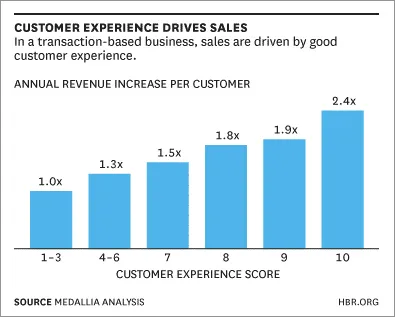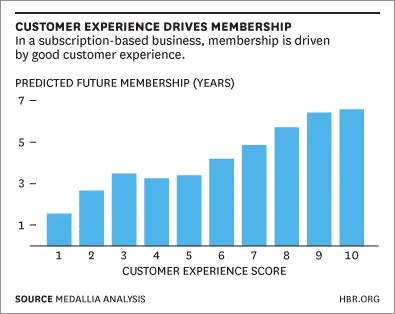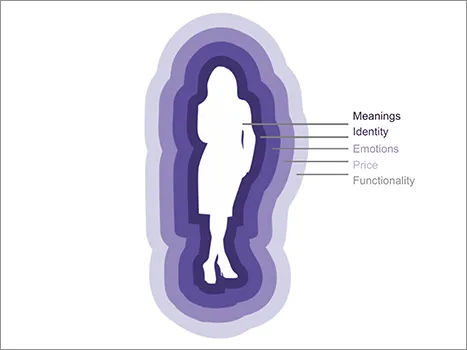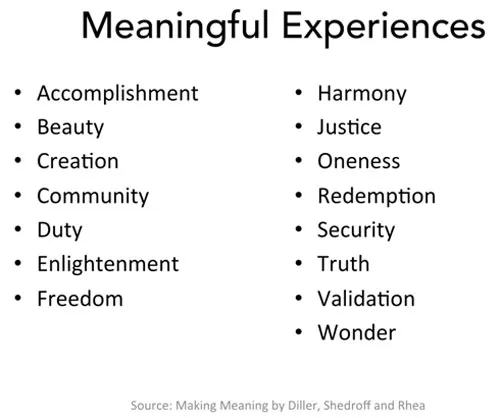Want loyal customers? Make them feel good

According to a study by McKinsey, “70% of the buying experiences are based on how the customer feels they are being treated.” In other words, 70% of the business has something to do with how you make your customers feel. We are indisputably in an experience economy. There is enough evidence to support that happy customers do translate into real revenue gains for both products and service companies (see figures 1 and 2).

Figure 1 Customer Experience Drives Revenue for Transactional Businesses

Figure 2 Customer Experience Increases Membership for Subscription Businesses
However, what is not clear is how we define customer experience. Is customer experience limited to UX/UI of your mobile app and website? Or is it limited to post-sale customer service? Should the experience have only functional (satisfactory, easy of use), and emotional (delightful) aspects?
An experience is a process we are conscious of and involved in as it happens, and hence it is very personal. It cannot be forced upon anyone what he or she experiences. Therefore, an experience cannot be created but can only be designed. And a design that is consistent across the breadth of touch-points and connects at customer’s deepest level of desires can evoke those experiences successfully.
There are two key elements to consider while designing an experience, the breadth of customer interaction with your brand and the depth at which your brand connects with the customer.
Breadth of customer experience
First, let us talk about the breadth of touch-points.Most companies focus on UX/UI of mobile app and website, and understand how they should be improving post-sale customer service experience. However, the essential touch-points, product development and service design are often neglected when it comes to considering customer experience needs. It isn’t enough to ask, “How did we do it?” and measure post-sale customer satisfaction, but even more important is to ask, “What is it that you want?” and design trulycustomer-centric products and services. Other touch-points of equal importance are marketing, sales, brand messaging, social media and distribution channels (see figure 3).

Figure 3 A Holistic Delivery Across All Touch-Points
Depth of customer experience
The depth at which a business should connect with customers through delivery of an experience is even less understood. Let’s take a look at which factors influence our decisions (see figure 4).

Figure 4 What Drives Our Decisions?
At the outer most layer of our psyche are the rational decisions of functionality and price-point. Does this product or service do what I need and is it worth the price? Beyond these logical decisions, some companies market emotions to customers. How does it make me feel? Emotions are harder to quantify, and they certainly do not last long. They are mostly used in advertising and marketing messages. Coke’s ‘Open Happiness’ is a prime example of it. Deeper than emotions is our desire to identity with some groups and standout from others. Is this product really Me? For example, I am a Mac guy (as opposed to a PC guy) and I identify with Coke more then Pepsi. At the deepest level of our being are our values and belief systems. Does this product or service fit into the world I have created for myself? Does it give me a sense that life’s worth living? Steve Diller and Nathan Shedroff have identified 15 such meaningful experiences derived from our value systems that are cross-cultural, relatively stable, and applicable to a wide range of our decisions (for detailed explanation of these meanings take a look at Making Meaning).
To name a few examples of companies successful at evoking such meanings in people’s lives,
Nike is in the business of evoking Accomplishment and not just selling you shoes.
Disney is all about Wonder and Happiness and not animated movies or theme parks.
Furniture giant Ikea is selling you Beauty, and also Accomplishment by taking the do-it-yourself movement to an entirely new level (you pick up and assemble your furniture).
Own Taj group of hotels is not selling you a room, but making you feel Validated that you are worth the pampering you get by their excellent service.
When you use P&G’s Gillette, Ariel washing powder, Duracell batteries or Pampers diapers, you can be assured of their products integrity and honesty (Truth).
And no such list is complete without a mention of Apple (Beauty and Community) and Starbucks (Creation and Truth) -- pioneers of end-to-end consistent, holistic, and authentic delivery of experience across the breadth of touch-points.
The meaningful experiences listed in figure 5 are not the only ones to pursue, but is a good starting point. Only by a thorough qualitative and ethnographic deep dive into customers’ lives a company can uncover what is it that they truly desire.

Figure 5: Meaningful Experiences

About the author:
Dhaval operates at the intersection of technology, business and design. He is a Founder and an experience strategist at Abir, which provides consulting service and training workshops on customer experience, innovation and business design. He can be reached at [email protected]







